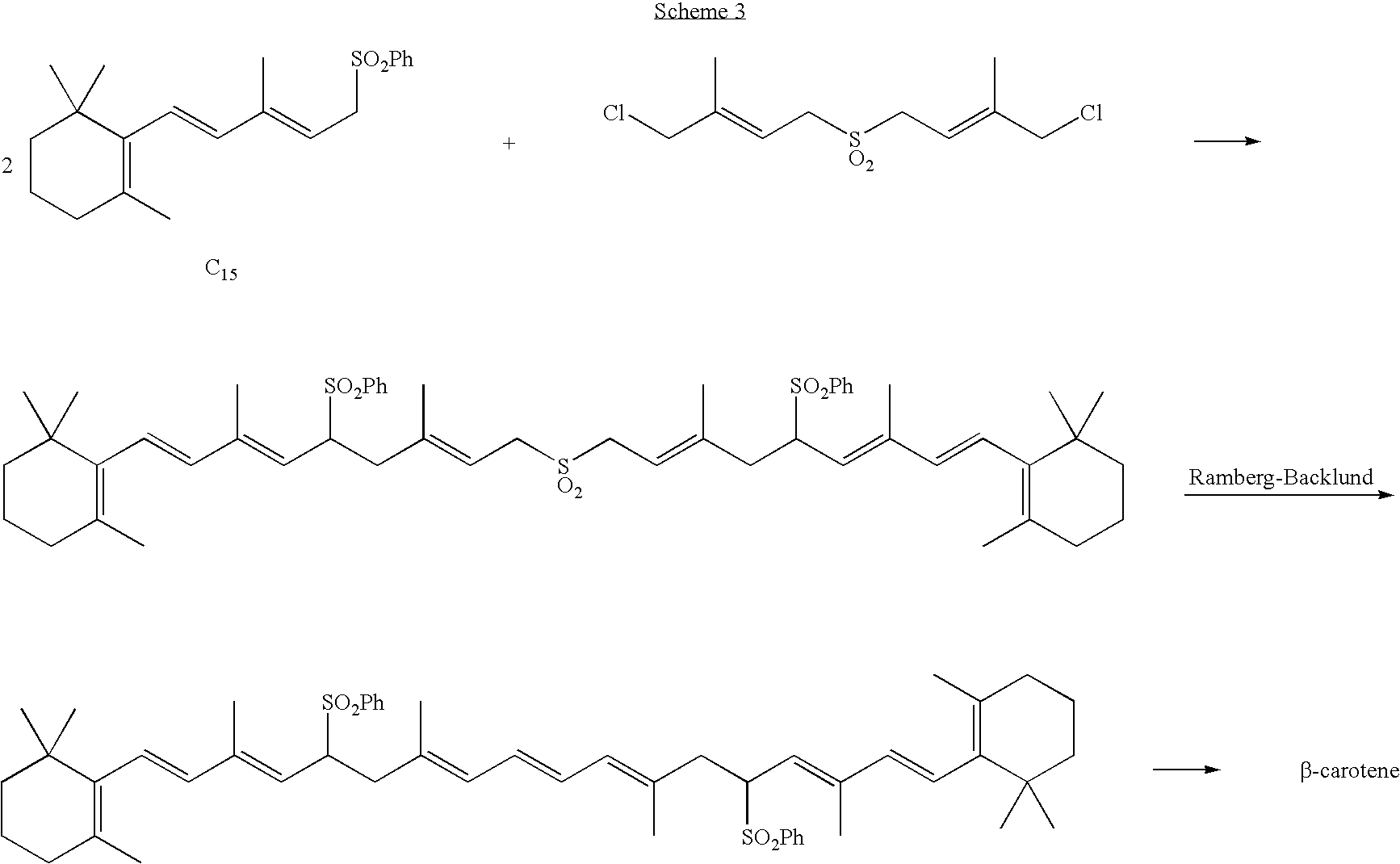C10 Dialdehyde, Synthetic Method Thereof, and Synthetic Method of Beta-Carotene Using the Same
- Summary
- Abstract
- Description
- Claims
- Application Information
AI Technical Summary
Benefits of technology
Problems solved by technology
Method used
Image
Examples
example 1
(E)-1,4-dibromo-2-butene (A)
[0041]1,3-Butadiene (60 mL, 0.70 mol) was received in a 500 mL round-bottomed flask which was placed into a −78° C. bath. CCl4 (100 mL), which was already cooled to −20° C., was slowly added to the above flask while maintaining the temperature of the mixture below −20° C. Bromine was then added to the above solution drop wise for 2 h at −20° C. The reaction mixture was stirred vigorously at room temperature for 14 h, and most of the solvent was removed under reduced pressure. The crude product was recrystallized from cold hexanes to give white crystalline 1,4-dibromide (A) (62.4 g, 0.29 mmol) in 58% yield.
[0042]Rf=0.74 (hexanes:EtOAc=4:1).
[0043]1H NMR (300.40 MHz, CDCl3) δ 3.89-4.02 (m, 4H), 5.90-6.05 (m, 2H) ppm.
example 2
2,7-Bis(ethoxycarbonyl)-2,7-dimethyl-4-octenedioic acid, diethyl ester (B)
[0044]To a stirred suspension of NaH (8.0 g, 0.20 mol, 60% dispersion in mineral oil) in THF (200 mL) was added a solution of diethyl methylmalonate (17.60 g, 0.10 mol) in THF (10 mL) at 0° C. The mixture was stirred at that temperature for 30 min, and a solution of (E)-1,4-dibromo-2-butene (A) (10.70 g, 50.0 mmol) in THF (10 mL) was added. The reaction mixture was slowly warmed to and stirred at room temperature for 14 h, and 1 M HCl solution was added. The mixture was extracted with Et2O, washed with H2O and brine, dried over Na2SO4, filtered, and concentrated under reduced pressure. The crude product was purified by SiO2 flash column chromatography (hexanes:EtOAc=10:1) to give the tetraester (B) (17.6 g, 44.0 mmol) in 88% yield
[0045]Rf=0.58 (hexanes:EtOAc=4:1).
[0046]1H NMR (300.40 MHz, CDCl3) δ 1.24 (t, J=7.2 Hz, 12H), 1.35 (s, 6H), 2.49-2.62 (m, 4H), 4.17 (q, J=7.2 Hz, 8H), 5.33-5.48 (m, 2H) ppm.
[0047]HRMS...
example 3
2,7-Dimethyl-4-octenedioic acid, dimethyl ester (C)
[0048]The mixture of the tetraester compound (B) (9.4 g, 23.5 mmol) and KOH (26.4 g, 47.0 mmol) in H2O (200 mL) was heated to reflux for 2 d. The reaction mixture was cooled to room temperature, and acidified to pH 1 by adding concentrated H2SO4. The resulting mixture was heated to reflux for 3 d, and then cooled to room temperature. The mixture was extracted with EtOAc, dried over Na2SO4, filtered, and concentrated under reduced pressure. The crude product (5.8 g) was dissolved in MeOH (80 mL), and treated with concentrated H2SO4 (3.5 mL). The mixture was then stirred at room temperature for 12 h. Most of the solvent was removed under reduced pressure. The concentrate was dissolved in EtOAc, washed with H2O, dried over Na2SO4, filtered, and concentrated under reduced pressure. The crude product was purified by SiO2 flash column chromatography (hexanes:EtOAc=4:1) to give the dimethyl ester (C) (4.75 g, 20.9 mmol) in 89% yield.
[0049]...
PUM
| Property | Measurement | Unit |
|---|---|---|
| Temperature | aaaaa | aaaaa |
| Temperature | aaaaa | aaaaa |
| Chemical formula | aaaaa | aaaaa |
Abstract
Description
Claims
Application Information
 Login to View More
Login to View More - R&D
- Intellectual Property
- Life Sciences
- Materials
- Tech Scout
- Unparalleled Data Quality
- Higher Quality Content
- 60% Fewer Hallucinations
Browse by: Latest US Patents, China's latest patents, Technical Efficacy Thesaurus, Application Domain, Technology Topic, Popular Technical Reports.
© 2025 PatSnap. All rights reserved.Legal|Privacy policy|Modern Slavery Act Transparency Statement|Sitemap|About US| Contact US: help@patsnap.com



